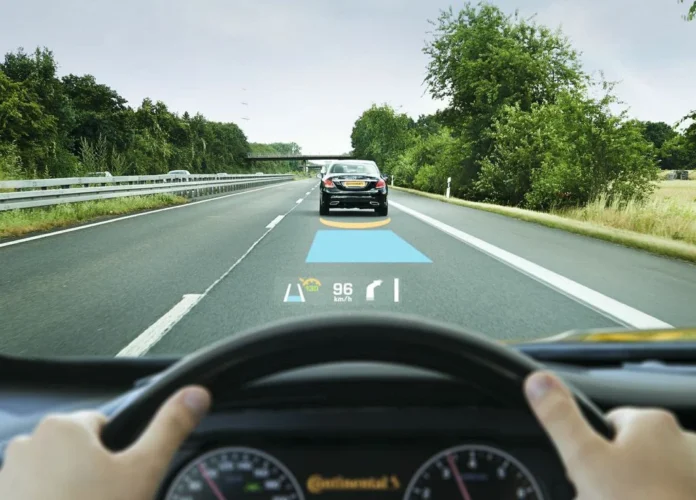As more technology comes into the car—from connected services like local search that require accurate input to driver-assist systems that issue a barrage of warnings—drivers will have to process more visual and audible stimuli. And without becoming distracted.
One solution to this information overload is head-up displays (HUDs) first used to keep fighter pilots on track and on target. HUDs have been available in cars for years, but mainly in more expensive vehicles. They’re also starting to appear in lower-priced cars like the 2014 Mazda 3 (which we reviewed) by using a small pop-up plastic panel on top of the dash as a display instead of the windshield.
 HUDs are poised to get better at presenting information to drivers thanks to the addition of augmented-reality technology. I got a firsthand glimpse of this next evolutionary step for HUDs last week by traveling to Germany, where automotive electronics giant Continental showed a concept of the first-ever augmented reality HUD.
HUDs are poised to get better at presenting information to drivers thanks to the addition of augmented-reality technology. I got a firsthand glimpse of this next evolutionary step for HUDs last week by traveling to Germany, where automotive electronics giant Continental showed a concept of the first-ever augmented reality HUD.
Several hours after landing in Frankfurt following an overnight flight (and while still somewhat sleep deprived), we were testing the technology behind the wheel on the autobahn and other roads. And right away it helped keep me from missing a turn or veering out of my lane more than once.
The prototype we tested was installed in a Kia K9 sedan and complemented the car’s existing HUD, which showed information such as speed, media selection, and basic navigation instructions. Continental’s augmented-reality technology added to this a layer of more dynamic information.
For example, when approaching a turn with a destination set by the navigation system, instead of a static arrow pointing the way, the AR HUD uses a dynamic fishbone-shaped display overlaid on the road to guide the driver through the maneuver. This was especially helpful when negotiating complicated intersections on unfamiliar roads.
An Amped-Up HUD
We found the technology especially helpful when paired with driver-assist systems such as adaptive cruise control (ACC) and lane departure warning (LDW) to provide distinct visual alerts. With ACC, it confirms that the system detects a vehicle ahead by placing a halo of light just underneath it, which changes colors to indicate how close you are to the vehicle (pictured, top). The HUD also graphically shows the ACC gap setting (how close the driver chooses to be to a vehicle in front) by overlaying it on the road.
 With LDW, a line of virtual semicircular road markers aligned perfectly with center and side stripes painted on the road (pictured below). To add to the effect, the K9’s haptic-seat warning vibrated as if the car was running over a real rumble strip when it veered off course over the 3D-like markers. A Continental engineer who rode along also showed how road warnings could be added to the system to indicate, say, an accident ahead or other hazard, once vehicle-to-vehicle and vehicle-to-infrastructure communication become common.
With LDW, a line of virtual semicircular road markers aligned perfectly with center and side stripes painted on the road (pictured below). To add to the effect, the K9’s haptic-seat warning vibrated as if the car was running over a real rumble strip when it veered off course over the 3D-like markers. A Continental engineer who rode along also showed how road warnings could be added to the system to indicate, say, an accident ahead or other hazard, once vehicle-to-vehicle and vehicle-to-infrastructure communication become common.
The only potential drawback to the technology is it could cause distraction on its own. Maybe it was just new to me—or the jetlag—but I found myself staring at the AR HUD a few times rather than looking through it at the road. But I believe I’d get used to it after a while and not really notice the display unless I needed certain info. Continental said it conducted numerous test and consumer focus groups to dial in the display and the data it shows to prevent distraction.
Continental expects the AR HUD technology to appear in production vehicles by 2017, although it hasn’t announced which automaker will be the first to use it. It will likely debut on higher-end cars, since HUD technology typically requires a specialized windshield. Jaguar recently introduced a similar AR HUD concept, but it covers the entire windshield. Continental also plans to make available a version of the AR HUD that uses a small plastic panel as the display, as in the Mazda 3, and this will help the technology to be more quickly adopted in lower-priced cars.
Technology being crammed into cars is often criticized as the cause of distraction among drivers. And while distraction will continue to be a dangerous issue as vehicles increasingly get connected, Continental’s augmented reality heads-up display concept shows that technology can also provide a solution to the problem.





